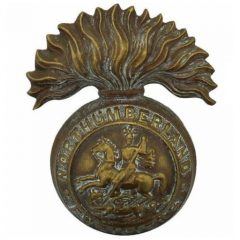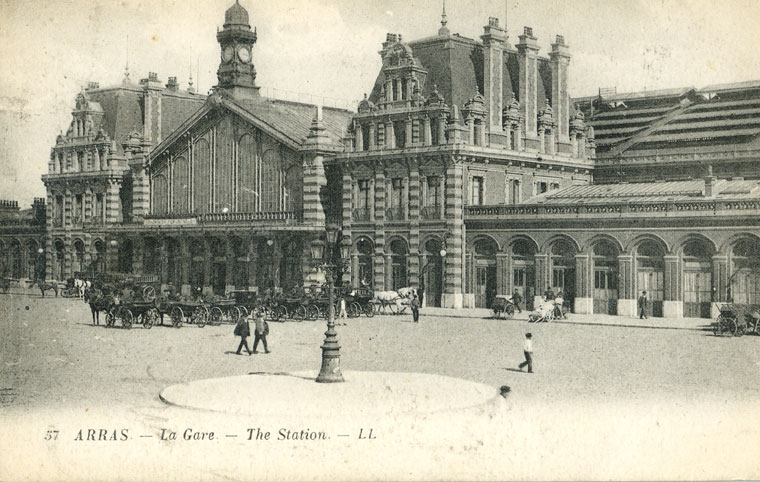Historical Context The allied plan to launch an offensive on two fronts in the spring of 1917 had started to take shape the year before, but it was put in jeopardy by the…
You must be logged in to view the content of this Chapter.
Footnotes
- It was not until the French advanced to compensate during the Battles of Arras that they encountered any German troops in the planned assault sector
- The two main squares in Arras are now called the Grand Place and Place des Héros
- 3rd Divn – was originally a regular army Divn, until 7th Bde replaced by 76th Bde. Comprised the 8th, 9th & 76th Bdes
- 12th (Eastern) Divn was part of Kitchener’s 1st New Army - Comprised the 35th, 36th & 37th Bdes
- 15th (Scottish) Divn was part of Kitchener’s 2nd New Army - Comprised the 44th, 45th & 46th Bdes
- Telegraph Hill: captured with the assistance of tanks on the 9th of April. Neuville Vitasse Map: 10-51BSW1-6A - Ref: M.12.b.7.6
- The Harp: Neuville Vitasse Map: 10-51BSW1-6A - Ref: M.12.b.7.6
- The 30th Divn was part of Kitchener’s ‘5th New Army’ Divn comprised of the - 21st , 89th and 90th Bdes,
- The 56th (1/1st London) Territorial Divn – was comprised of the 167th, 168th and 169th Bdes
- The 14th (Light) was part of Kitchener’s ‘1st New Army’ Divn - comprised of the 41st, 42nd and 43rd Infantry Bdes
- The 21st Divnh was part of Kitchener’s 3rd New Army comprised of 62nd, 64th & 110th Bdes
- 8 Coy, ‘C’ Battalion, Heavy Branch Machine Gun Corps employed tanks C21 (578), C22 (776), C23 (582), C26 (787), C27 (588), C28 (790), C29 (597), C36 (600), C39 (599)
- Hill 145 -
- Russian Saps were narrow tunnels dug towards the enemy line just below the surface so that there minimal, or no noticeable, disturbance on the surface. A sap trench enabled raiders to approach enemy lines as close as possible without being detected
- Observation Ridge – Ran north from Tilloy les Mofflaines towards Athies
- Hill 90 - map reference
- Falkenhausen commanded the German 6th Army at the Battle of Arras in April 1917. He failed to deploy correctly the newly-developed defence in depth to counter new British and Dominion tactics and was removed from field command by General Erich Ludendorff
- [zotpressInText item="{K7ZVR4JR,192}"]
- The battalion 1st line transport (1914) comprised five Small Arms Ammunition (SAA) and two water carts, two General Service (GS) limbered wagons for tools, one Maltese (Medical) cart, limbered wagon for machine guns, pack and spare animals; cooks wagon or four travelling kitchens (one per Coy)
- The Arras Citadelle was one of several star-shaped fortresses designed by Vauban. In 1659, the town of Arras came under the authority of the King of France for good and was incorporated into Vauban’s "pré carré", a double line of fortified towns built to protect the north-eastern border of the kingdom. The citadel was one of Vauban’s first constructions and took from 1668 to 1670 to build
- Telegraph Hill was a German Redoubt captured with the assistance of tanks on the 9th of April. Neuville Vitasse Map: 10-51BSW1-6A - Ref: M.12.b.7.6
- 41st Bde (14th Divn)
- Héninel, Wancourt and a 2000 yard length of the Hindenburg Line south of the Cojeul River were captured by troops from the 21st and 56th Divns
- Wancourt Tower ceased to exist as a landmark on the night of the 13th April. Vis en Artois map: 51b SW2-7A. Ref: N.24.d.1.0. Lat Long 50°14.31N 2°53.03 E
- Telegraph Hill was a German Redoubt captured with the assistance of tanks on the 9th of April. Neuville Vitasse Map: 10-51BSW1-6A - Ref: M.12.b.7.6
- 56th (1/1st London) Territorial Divn – Consisted of the 167th, 168th and 169th Bde
- Wancourt village - Vis en Artois map: 51b SW2-7A. Ref: N.23.a
- N.7.a
- Lt Col. Francis Robinson was formerly a Coy commander in the 4th NF and believed to serving with 6th NF by this time
- Capt. Wilfrid Bunbury is buried at Wancourt British Cemetery, Pas de Calais, France
- Pte John Mooney (235206) (b. Newcastle) (e. Newcastle) is buried in Wancourt British Cemetery, Pas de Calais, France
- The order to Stand-to was usually given an hour before dawn and dark. The men in the front line would man the fire step with fixed bayonets as this was considered to be the time the enemy was most likely to attack
- The French ‘Nivelle’ offensive was launched along 25 miles of the Aisne front on the 16th of April
- The Machine Gun Corps (MGC) was formed in October 1915 and was comprised of machine gun Coys. An Infantry MGC Coy was attached to every Infantry Bde, the men and guns originating from the battalion machine gun sections. 149th MGC was formed 6 Feb 1916
- Pte Thomas Augustine Brady (4/3247, 235216) 1/7th Bn? is commemorated on the Arras Memorial
- Cpl Matthew Winchester (4/7303, 203079) (b. Wooler) (e. Wooler), Northumberland. Matthew is buried in Wancourt British Cemetery
- Pte Henry Taylor (202216) (b. Acklington) (e. Newcastle). Non-Combatant Corps (1853) Pte. Northumberland Fusiliers (37603). Henry is commemorated on the Arras Memorial
- The Crossroads – west of Wancourt - Map Ref: N.22.a.7.4
- Hetsas Street communication trench - Map: 51BNW3-6A Ref: 34.d.8.8
- The Factory, Ronville – Arras Map: 51BNW3-6A Ref: G.35.a.1.9

